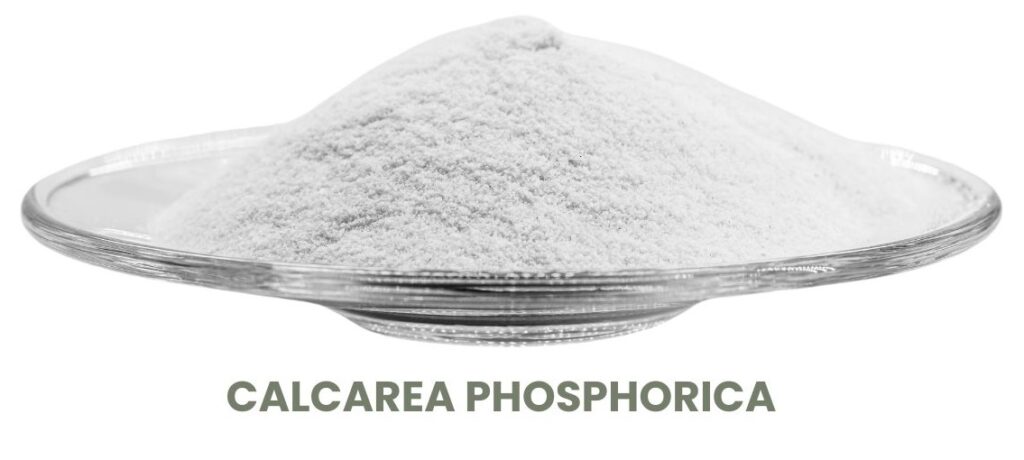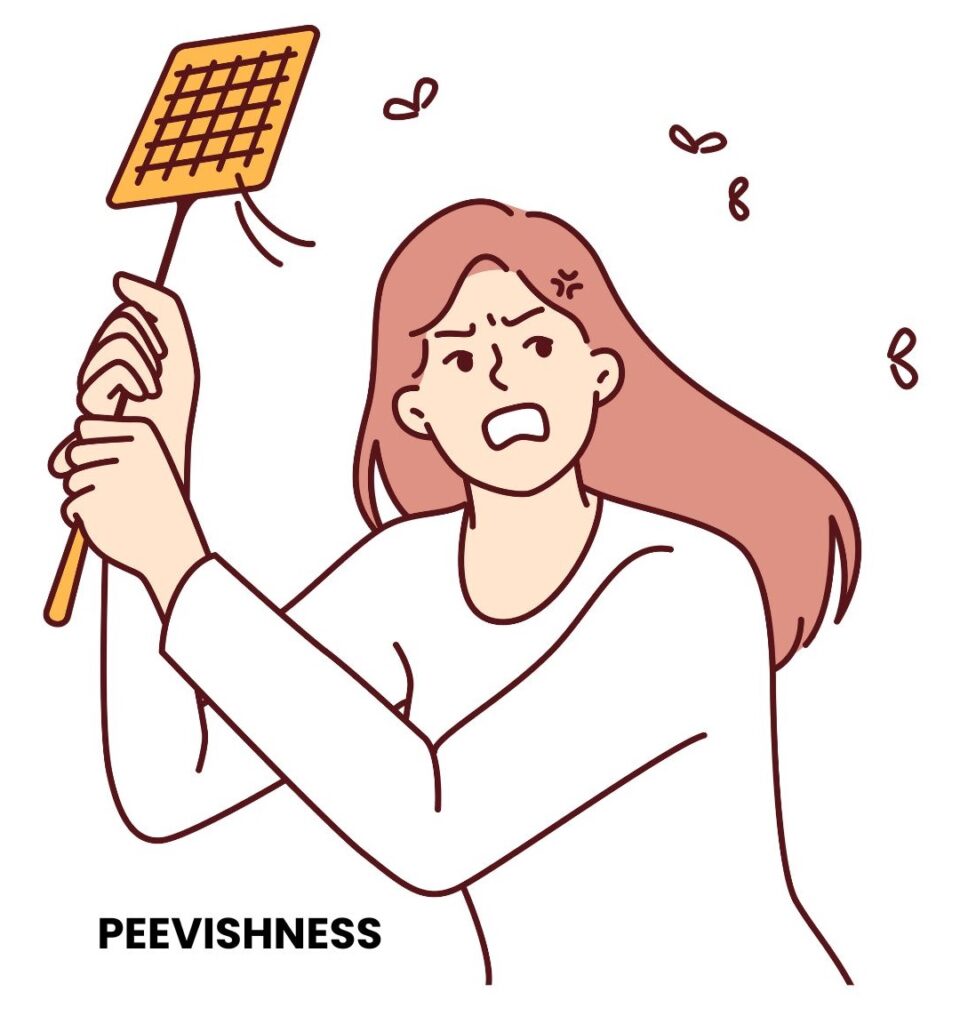Calcarea Phosphorica, commonly referred to as Phosphate of Lime, is a fundamental tissue remedy in homeopathy, with a broad scope of action, especially on the bones, glands, and digestive system.
It is particularly indicated for conditions involving poor bone development, delayed growth, and anemia.
Calcarea Phosphorica is a versatile remedy that is primarily indicated for issues related to bone development, delayed dentition, and non-union of fractures.
It plays a crucial role in the formation of bones and teeth, making it a key remedy for growing children who may suffer from nutritional deficiencies or developmental delays.
It is also useful for anemia following chronic illnesses and wasting diseases.

Table of Contents
ToggleSOURCE INFORMATION
Scientific Classification
- Chemical Composition: Calcium phosphate (Ca₃(PO₄)₂), an essential mineral compound that plays a vital role in bone and tooth development.
- Source: Derived from phosphate of lime, a natural mineral found in bones and teeth.
Origin in Homeopathy
- Calcarea Phosphorica was introduced as a tissue remedy by Wilhelm Heinrich Schusler, a German physician who identified it as one of the key inorganic substances needed for maintaining the structure of cells and tissues.
Historical Facts
- Calcarea Phosphorica has been used in homeopathy since the 19th century, mainly for treating conditions involving weak bones, delayed dentition, and poor nutritional absorption.
- It is also recognized for its ability to promote healing in cases of fractures and bone diseases.
DRUG PATHOGENESIS
- Calcarea Phosphorica acts on the bones, glands, and digestive system.
- It is especially beneficial for children and adolescents with delayed physical development, tardy dentition, and conditions where bones do not properly unite after fractures.
- The remedy also addresses mental and emotional states like peevishness, forgetfulness, and a constant desire to go somewhere.
- It is indicated when symptoms worsen from changes in weather, especially damp, cold conditions.
PHYSICAL CONSTITUTION
- Suited for weak, emaciated, and anaemic children who are slow to develop physically and mentally.
DIATHESIS
- Scrofulous (glandular swellings and susceptibility to infections) and phthisical (predisposed to tuberculosis).
TEMPERAMENT
- Peevish, irritable, and forgetful individuals who desire constant movement or change.
THERMAL STATE
- The thermal state of Calcarea phosphorica is characterized by sensitivity to cold and damp weather.
- Patients who need this remedy generally feel worse in cold, wet, and drafty conditions.
- They tend to feel cold easily, and their symptoms are aggravated by exposure to cold air or cold winds.
- However, they feel better in warm and dry weather, and summer generally brings relief.
- This sensitivity to changes in weather, especially from warm to cold or damp, is a key aspect of Calcarea phosphorica’s thermal state.
In summary
- Worse: Exposure to cold, damp weather, draft, and melting snow.
- Better: Warm, dry atmosphere, summer, and in general, warmth.
KEY CHARACTERISTICS
- Delayed Dentition: Sluggish development of teeth, where teeth take longer to erupt and may decay rapidly.
- Bone Disease: Poor bone formation, leading to conditions like rickets, non-union of fractures, and open fontanelles.
- Anemia: Weak, pale children who have cold extremities and poor digestion, often following acute diseases.
- Worse from Weather Changes: Symptoms are aggravated by damp, cold weather, particularly during the transition from winter to spring.
MIND SYMPTOMS
PEEVISHNESS (irritability and restlessness)

- Peevishness in Calcarea Phosphorica patients is marked by irritability, frustration, and a lack of patience.
- They are easily annoyed, often over minor things.
- This state is frequently observed after experiencing grief, disappointment, or emotional setbacks.
Explanation
- This emotional irritability can stem from physical or mental exhaustion, and it manifests as a constant feeling of discontent.
- Small inconveniences or unmet expectations trigger their irritability.
- For children, this is often seen in delayed physical development stages, such as teething or bone growth, where the child becomes whiny and difficult to console.
- Adults may express this frustration through frequent complaints and a tendency to be critical of their surroundings or relationships.
- This symptom reflects the patient’s overall emotional fragility.
FORGETFULNESS (Difficulty in Retaining Information)

- Patients often exhibit poor memory and an inability to retain or recall information.
- This forgetfulness can affect everyday tasks, conversations, or even important commitments.
Explanation
- Forgetfulness in Calcarea Phosphorica may be linked to mental fatigue and exhaustion.
- It indicates a form of cognitive dullness, where the mind struggles to focus or hold onto details.
- The patient may appear absent-minded, easily losing track of conversations, appointments, or tasks.
- This could be due to the mental restlessness and dissatisfaction they experience, which prevents them from being fully present in the moment, leading to memory lapses.
DESIRE TO TRAVEL (Mental Restlessness or Dissatisfaction)

- A distinct feature of Calcarea Phosphorica patients is a constant desire to be on the move, to travel, or to change their surroundings.
- They may express the need to go somewhere new or engage in a different activity, indicating internal restlessness.
Explanation
- This mental restlessness suggests dissatisfaction with their current situation, environment, or life circumstances.
- The desire to travel is symbolic of an inner yearning for change or escape from the monotony they feel trapped in.
- It can also be seen as a search for mental stimulation or relief from the emotional discomfort they face.
- In some cases, it reflects an underlying sense of boredom or emotional emptiness, where the patient seeks external activities to fill an internal void.
Summary
The mind symptoms of Calcarea Phosphorica reflect an individual who is emotionally sensitive and easily agitated, often due to mental and physical weariness.
Peevishness arises from dissatisfaction, forgetfulness stems from cognitive fatigue, and the desire to travel reflects an inner need for change or relief from discontent.
These traits are especially pronounced during periods of growth, development, or after emotional trauma, where the mind and body are not in harmony.
DETAILED ORGAN SYMPTOMS
HEAD
- Headaches: Particularly over the sutures of the skull, worsened by weather changes, often seen in school children.
- Open Fontanelles: The soft spots on a baby’s skull remain open for an extended period, indicating delayed bone development.
- Soft Cranial Bones: The skull bones are thin and soft, contributing to developmental delays.
EYES
- Opacity in Cornea: Diffused clouding of the cornea, often following an abscess.
MOUTH
- Slow Dentition: Teeth develop slowly, and the child experiences pain during teething.
- Swollen Tonsils: Tonsils become enlarged, causing pain when opening the mouth.
- Adenoid Growths: Swelling and enlargement of adenoids, which can obstruct breathing.
STOMACH
- Constant Hunger: Particularly in infants, who want to nurse all the time but vomit easily.
- Craving for Salty or Smoked Foods: A desire for bacon, ham, and other salted or smoked meats.
- Flatulence and Heartburn: Excessive gas with sour eructations and burning sensations in the stomach.
ABDOMEN
- Colicky Pains: Cramping pain around the navel, worsened by eating.
- Sunken Abdomen: Abdomen appears flabby and sunken, a sign of poor nutritional absorption.
STOOL
- Diarrhea: Green, slimy, undigested stools with a fetid odor, often seen during teething.
- Bleeding with Hard Stool: Hard, difficult stool that causes rectal bleeding.
URINARY SYSTEM
- Frequent Urination: Increased urine output, accompanied by a sensation of weakness.
- Kidney Pain: Pain in the region of the kidneys, aggravated by lifting or blowing the nose.
FEMALE REPRODUCTIVE SYSTEM
- Early and Heavy Menses: Girls experience early, profuse, and bright-colored menstrual periods.
- Leucorrhea: White, egg-like vaginal discharge, particularly in the morning.
- Nymphomania: Excessive sexual desire, particularly during or after lactation.
RESPIRATORY SYSTEM
- Involuntary Sighing: A tendency to sigh frequently, indicating underlying emotional or respiratory distress.
- Suffocative Cough: Cough that is relieved by lying down.
- Pain in Left Lung: Pain radiating through the lower part of the left lung.
NECK AND BACK
- Rheumatic Pain: Stiffness and pain in the neck and back, particularly in the sacroiliac region, often feeling as if the bones are broken.
EXTREMITIES
- Stiffness and Numbness: Coldness, crawling sensations, and stiffness in the limbs, worsened by cold weather or damp conditions.
MODALITIES
- Worse: Cold, damp weather, especially during transitions from winter to spring or from melting snow.
- Better: Warm, dry weather, particularly in the summer.
WHAT ARE MODALITIES IN HOMOEOPATHY?
RELATIONSHIP WITH OTHER REMEDIES
Complementary Remedies
- Ruta is often used to complement Calcarea Phosphorica, particularly in cases of bone and joint ailments.
- Both remedies work well together in treating bone injuries, joint stiffness, and tendon issues.
- While Calcarea Phosphorica strengthens bone and aids in recovery after fractures, Ruta helps with ligament and tendon damage, especially after overuse or strain.
- Hepar is useful alongside Calcarea Phosphorica for treating glandular swellings and suppurations (formation of pus).
- It is often indicated in chronic abscesses and conditions where the body has difficulty in clearing infections.
- When combined with Calcarea Phosphorica, it enhances healing in cases of prolonged abscesses and slow recovery from infections.
Comparative Remedies
CALCAREA HYPOPHOSPHOROSA
- Calcarea Hypophosphorosa is preferred when there is a need to supplement the body with high doses of phosphorus due to continued abscesses that have significantly weakened the vitality.
- It is particularly useful when the patient exhibits signs of loss of appetite, rapid debility, and night sweats.
- Key Symptoms: This remedy is especially effective for patients with acne pustulosa (pustular acne), pallor of the skin, cold extremities, tuberculosis, and symptoms of phthisis (wasting diseases) such as chronic cough and diarrhea.
- It is also useful in treating mesenteric tuberculosis, angina pectoris, and asthma.
- One notable symptom is acute chest pains that occur about two hours after meals, relieved by a small snack or a cup of milk.
CALCAREA RENALIS (Lapis Renalis)
- Used for: Calcarea Renalis is useful in treating conditions such as arthritic nodosities (bony growths associated with arthritis) and Rigg’s disease (periodontal disease), where there is a tendency for tartar accumulation on the teeth.
- This remedy helps reduce the formation of gravel and renal calculi (kidney stones).
- Indications: It is particularly beneficial in cases involving renal calculi or gravel, helping to dissolve or reduce these deposits.
CONCHILION (Mother of Pearl)
- Specific Uses: This remedy, also known as Mother of Pearl, has a wide range of action in bone affections, particularly where there is involvement of the growing ends of the bones.
- It is effective in treating osteitis (inflammation of the bone) and in conditions characterized by petechiae (small red or purple spots caused by bleeding into the skin).
- Key Symptoms: Conchilion is useful for treating bone diseases and conditions with chronic inflammation of bone tissues.
Other Comparisons
SILICA: Often compared to Calcarea Phosphorica, Silica is used in conditions involving delayed healing and suppurations.
Both remedies share a tendency to improve chronic conditions that involve slow recovery and glandular swellings.
PSORINUM: Psorinum is indicated in cases where there is extreme debility, chronic conditions, and sensitivity to cold.
Like Calcarea Phosphorica, Psorinum patients often suffer from weakness after acute illnesses, making it a remedy of comparison.
SULPHUR: Sulphur complements Calcarea Phosphorica in cases involving chronic skin conditions, especially those with suppurations, eczema, and eruptions.
Both remedies work well for patients with glandular enlargement and a tendency to slow healing.
DOSE
- The first to third trituration is most commonly prescribed, but higher potencies are often more effective, especially for chronic conditions.
Frequently Asked Questions
What is Calcarea Phosphorica used for?
- Calcarea Phosphorica is mainly used for bone growth issues, delayed dentition, non-union of fractures, and anemia, especially in children.
Who can benefit from Calcarea Phosphorica?
- Children and adolescents with developmental delays, weak bones, and nutritional deficiencies can benefit most from this remedy.
Can Calcarea Phosphorica be used for fractures?
- Yes, it is especially useful in promoting the healing of fractures, particularly when bones fail to unite.
How is Calcarea Phosphorica different from Calcarea Carbonica?
- Calcarea Phosphorica is indicated for delayed development of bones and teeth, while Calcarea Carbonica is more suited for general weakness and a tendency to gain weight easily.
What are the key symptoms of Calcarea Phosphorica?
- Key symptoms include delayed dentition, bone diseases, non-union of fractures, and a craving for salty or smoked foods.
Glossary of Difficult Words
- Scrofulous: A condition involving glandular swellings, often related to tuberculosis.
- Phthisical: A tendency towards tuberculosis or other wasting diseases.
- Adenoids: Lymphatic tissue at the back of the nasal cavity that can become enlarged, especially in children.
- Nymphomania: Excessive or uncontrollable sexual desire.
- Leucorrhea: A thick, whitish vaginal discharge.
